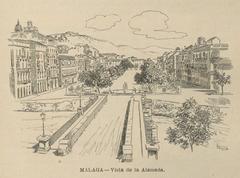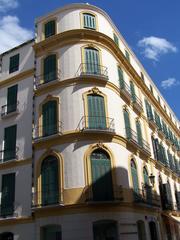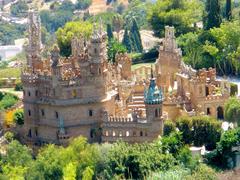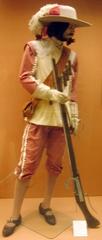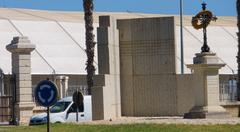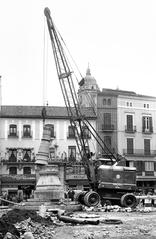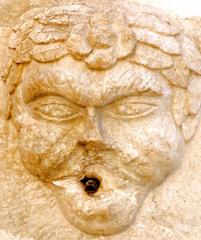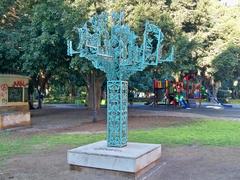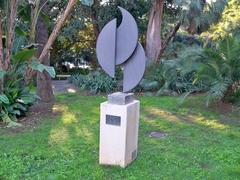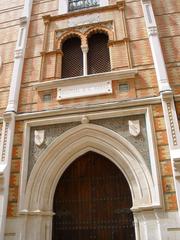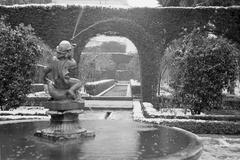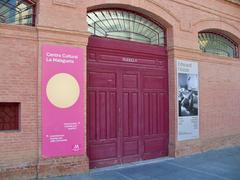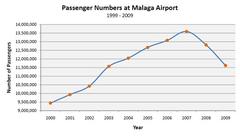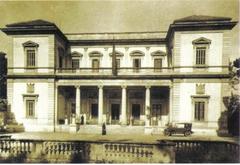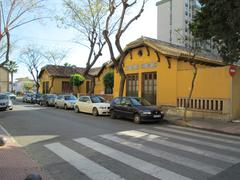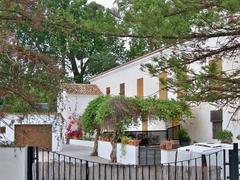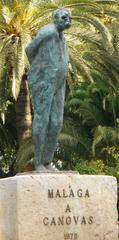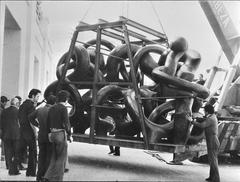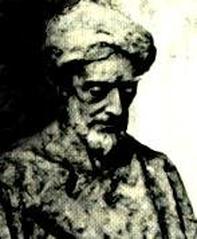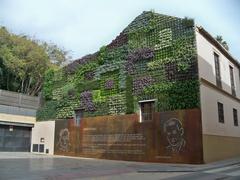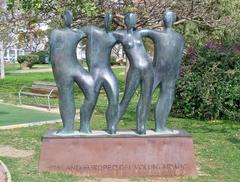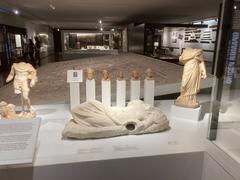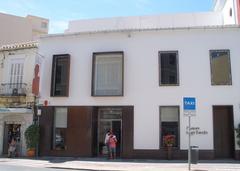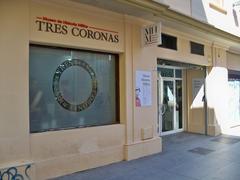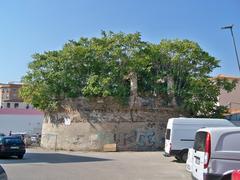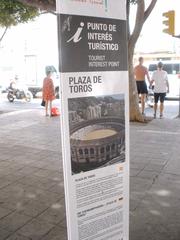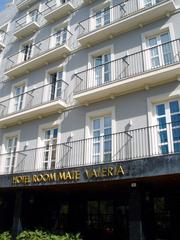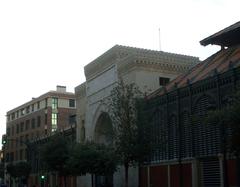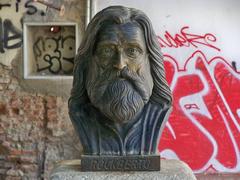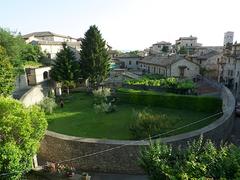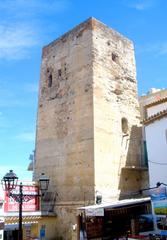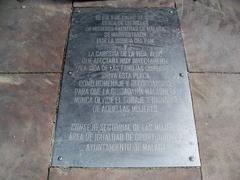Comprehensive Guide to Visiting Alcazaba de Málaga, Málaga, Spain
Date: 17/07/2024
Introduction
The Alcazaba de Málaga, nestled in the heart of Málaga, Spain, stands as a formidable testament to the region’s rich, multifaceted history. Originally constructed in the 8th century under the Umayyad dynasty, this iconic palatial fortress has borne witness to numerous epochs of change, from its initial role as a defensive stronghold to its later transformation into a luxurious palace under the Nasrid dynasty (Alcazaba de Málaga History). The fortress’s strategic location on Gibralfaro hill provided a commanding vantage point over the Mediterranean Sea, making it a prime site for defense and a hub of political power throughout various historical periods. Over centuries, the Alcazaba has evolved, reflecting the architectural and cultural shifts brought about by different rulers, including significant expansions under the Hammudid and Nasrid dynasties and adaptations during the Christian Reconquista (Hammudid Dynasty, Nasrid Architecture). Today, the Alcazaba de Málaga not only serves as a remarkable historical monument but also as a vibrant cultural symbol, attracting thousands of visitors annually who come to explore its ancient walls, lush gardens, and panoramic views of Málaga (Reconquista).
Table of Contents
- Introduction
- History of Alcazaba de Málaga
- Architectural Significance
- Visitor Information
- Nearby Attractions
- Special Events and Photographic Spots
- Preservation Efforts
- FAQ
- Conclusion
History of Alcazaba de Málaga
Origins and Early Construction
The Alcazaba de Málaga, a palatial fortress, stands as a testament to the rich and diverse history of Málaga, Spain. Its origins date back to the 8th century during the reign of the Umayyad dynasty. The initial construction began under the orders of Abd al-Rahman I, the first Emir of Córdoba, who sought to establish a fortified stronghold to protect the city from potential invasions. The strategic location on the Gibralfaro hill provided a vantage point over the Mediterranean Sea and the surrounding lands, making it an ideal site for defense (Alcazaba de Málaga History).
Expansion Under the Hammudid Dynasty
Significant expansions and renovations occurred in the 11th century under the Hammudid dynasty. The Hammudids, who declared their independence from the Caliphate of Córdoba, transformed the Alcazaba into a more formidable fortress. They added new walls, towers, and gates, enhancing its defensive capabilities. The construction techniques employed during this period reflected the advanced engineering skills of the time, incorporating features such as double walls and fortified gates to withstand sieges (Hammudid Dynasty).
The Nasrid Period
The most notable period of development for the Alcazaba occurred during the Nasrid dynasty in the 13th and 14th centuries. The Nasrids, who ruled the Emirate of Granada, undertook extensive renovations to transform the Alcazaba into a luxurious palace-fortress. This period saw the construction of intricate gardens, ornate courtyards, and lavish residential quarters. The Nasrid influence is evident in the architectural details, including the use of horseshoe arches, stucco decorations, and intricate tilework (Nasrid Architecture).
The Reconquista and Christian Era
The fall of Málaga to the Catholic Monarchs, Ferdinand and Isabella, in 1487 marked a significant turning point in the history of the Alcazaba. The fortress was captured after a prolonged siege, and it subsequently became a symbol of Christian dominance in the region. The Catholic Monarchs ordered the construction of new defensive structures, including the addition of artillery platforms to adapt to the changing nature of warfare. Despite these modifications, the Alcazaba retained much of its Moorish architectural heritage (Reconquista).
Decline and Restoration
Following the Reconquista, the Alcazaba gradually fell into disrepair. By the 18th century, it had lost much of its strategic importance and was largely abandoned. The fortress suffered further damage during the Napoleonic Wars and the Spanish Civil War. However, the 20th century saw a renewed interest in preserving this historical monument. Extensive restoration efforts were undertaken to stabilize the structure and restore its former glory. These efforts have allowed the Alcazaba to become a major tourist attraction, offering visitors a glimpse into its storied past (Restoration Efforts).
Architectural Significance
The Alcazaba de Málaga is a prime example of Moorish military architecture. Its design incorporates elements typical of Islamic fortresses, such as the use of geometric patterns, water features, and lush gardens. The fortress is divided into two main enclosures: the lower precinct, which served as the military and administrative center, and the upper precinct, which housed the residential quarters and palatial buildings. The layout of the Alcazaba reflects the hierarchical nature of Moorish society, with the most important buildings located in the upper precinct (Moorish Architecture).
Visitor Information
Ticket Prices and Visiting Hours
The Alcazaba de Málaga is open to visitors throughout the year. Standard visiting hours are from 9 AM to 8 PM in the summer and 9 AM to 6 PM in the winter. Ticket prices are very reasonable, with discounts available for students, seniors, and children. It’s advisable to purchase tickets in advance online to avoid long queues at the entrance (Alcazaba de Málaga Tickets).
Guided Tours and Educational Programs
For a more enriching experience, consider joining a guided tour. These tours are available in multiple languages and offer in-depth insights into the history and architecture of the Alcazaba. Educational programs and interactive exhibits are also available, making it an excellent destination for school groups and history enthusiasts alike.
Travel Tips
- Getting There: The Alcazaba is conveniently located in the heart of Málaga and can be easily accessed by public transport, car, or on foot. The nearest bus stop is just a few minutes’ walk away.
- Best Time to Visit: To avoid the crowds, visit early in the morning or late in the afternoon. The fortress is especially beautiful during sunset, offering stunning views of the city and the Mediterranean Sea.
- Accessibility: The site is partially accessible to visitors with limited mobility. However, some areas may be challenging due to the steep terrain and uneven surfaces.
Nearby Attractions
While visiting the Alcazaba, make sure to explore other historical sites in Málaga, such as the Gibralfaro Castle, the Roman Theatre, and the Málaga Cathedral. These landmarks are within walking distance and offer a deeper understanding of the city’s rich heritage.
Special Events and Photographic Spots
The Alcazaba hosts various cultural events and festivals throughout the year, including music concerts, art exhibitions, and historical reenactments. These events provide a unique opportunity to experience the fortress in a different light. Don’t forget to bring your camera, as there are numerous spots within the Alcazaba that offer perfect photo opportunities.
Preservation Efforts
Ongoing preservation efforts are crucial to maintaining the integrity of the Alcazaba. The local government, in collaboration with heritage organizations, continues to invest in the conservation and restoration of the fortress. These efforts include structural repairs, archaeological excavations, and the implementation of modern technologies to monitor and protect the site. The goal is to ensure that the Alcazaba remains a vibrant and accessible historical monument for future generations (Preservation Efforts).
FAQ
Q: What are the visiting hours for the Alcazaba de Málaga? A: The Alcazaba is open from 9 AM to 8 PM in the summer and 9 AM to 6 PM in the winter.
Q: How much do tickets cost? A: Ticket prices are affordable, with discounts available for students, seniors, and children. It’s best to check the official website for the most up-to-date pricing.
Q: Are guided tours available? A: Yes, guided tours are available in multiple languages and provide in-depth insights into the fortress’s history and architecture.
Q: Is the Alcazaba accessible for visitors with limited mobility? A: The site is partially accessible, but some areas may be challenging due to steep terrain and uneven surfaces.
Q: What other attractions are nearby? A: Nearby attractions include the Gibralfaro Castle, the Roman Theatre, and the Málaga Cathedral.
Conclusion
The Alcazaba de Málaga is a remarkable historical monument that encapsulates the rich and diverse history of the region. Its origins, architectural significance, and cultural impact make it a must-visit destination for anyone interested in the history and heritage of Spain. Plan your visit today to explore its ancient walls, enjoy panoramic views, and immerse yourself in the fascinating history of Málaga.
For more updates and travel tips, download our mobile app Audiala, and follow us on social media. Don’t forget to check out our other related posts for more exciting historical sites to explore!
References
- Alcazaba de Málaga History. Retrieved from https://www.andalucia.com/cities/malaga/alcazaba.htm
- Hammudid Dynasty. Retrieved from https://www.britannica.com/topic/Hammudid-dynasty
- Nasrid Architecture. Retrieved from https://www.alhambra-patronato.es/en/discover/nasrid-art
- Reconquista. Retrieved from https://www.britannica.com/event/Reconquista
- Restoration Efforts. Retrieved from https://www.malagaturismo.com/en/attractions/alcazaba/3
- Moorish Architecture. Retrieved from https://www.islamic-arts.org/2020/moorish-architecture-in-spain/
- Cultural Events. Retrieved from https://www.malagaturismo.com/en/what-to-see/monuments/alcazaba/3
